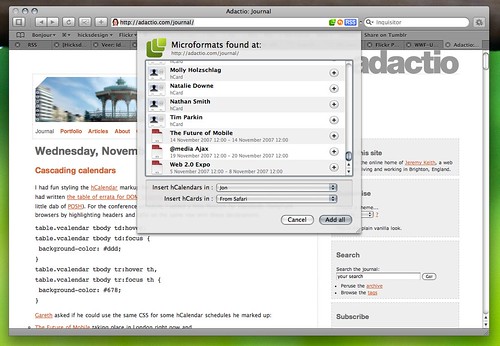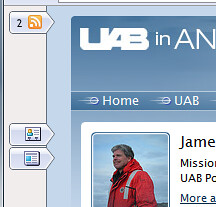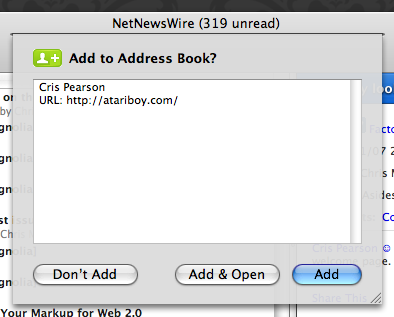user-interface: Difference between revisions
(Safari microformats plug-in now available) |
No edit summary |
||
| Line 20: | Line 20: | ||
=== Currently === | === Currently === | ||
* The [[Flock]] browser ships with microformats support built-in. | * <del>The [[Flock]] browser ships with microformats support built-in.</del> - This has not been confirmed. -- Chris Messina. | ||
* The [[Operator]] plug-in adds microformats detection and integration to [[Firefox]] version 1.5-2, and [[Netscape Navigator]] versions 9+ <br /> [http://notizblog.org/2007/10/21/operator-unter-navigator-90/ http://notizblog.org/wp-content/uploads/2007/10/micro-netscape.png] | * The [[Operator]] plug-in adds microformats detection and integration to [[Firefox]] version 1.5-2, and [[Netscape Navigator]] versions 9+ <br /> [http://notizblog.org/2007/10/21/operator-unter-navigator-90/ http://notizblog.org/wp-content/uploads/2007/10/micro-netscape.png] | ||
* A [[Safari|Safari microformats plugin]] has been implemented (requires OSX10.5+) based on Jon Hicks's mockup: <br /> [http://microformats.org/wiki/safari http://farm3.static.flickr.com/2309/2036669631_6e99870645.jpg] | * A [[Safari|Safari microformats plugin]] has been implemented (requires OSX10.5+) based on Jon Hicks's mockup: <br /> [http://microformats.org/wiki/safari http://farm3.static.flickr.com/2309/2036669631_6e99870645.jpg] | ||
Revision as of 07:36, 24 November 2007
User Interface
Recently there have been many really good user interface ideas and suggestions for working with microformats. This page serves to collect and document them so that we may be inspired by and iterate on each others' works.
Design Guidelines
These are some suggested design guidelines for Web designers and developers by Alex Faaborg, a user experience designer at Mozilla:
- Design based on actions, not data. A button that says "Send to Calendar" is considerably more useable than a green button that simply says "hCalendar"
- Use iconic images instead of acronyms. In addition to being more descriptive, they localize better. Here are some I've been showing in various talks: microformat icons. These are still very preliminary. Mozilla will likely release all of the source artwork for our microformat icons under a creative commons license around the launch of Firefox 3. This will enable Web designers to integrate the icons into their sites, and other Web browsers can consider using a similar set of icons.
Design Challenges
- Chris Messina: "What kind of solutions can we come up with that are single click only?"
- Alex Faaborg: Mozilla has had inquiries from reporters in the mainstream media (Wired and Business Week) who wanted to cover microformats in stories about the future of the Web browser, but they then later backed out because they felt the term "microformats" would only appeal to developers, and not the average reader. These types of mainstream stories need to focus on the user experience, and not the underlying technology, but what term should reporters use to describe the overall feature?
- I think we should stick with the term "microformats" until someone comes up with a better term that doens't "only appeal to developers". Note that we should avoid terms which are either overloaded, or dilute the concepts, or are just another form of made-up jargon. Tantek
Social Network Portability
See the separate social-network-portability page.
Browser Integration
From visions to screenshot brainstorms to working plugins to shipping implementations, there is a lot going on with browser integration of microformats support.
Currently
The Flock browser ships with microformats support built-in.- This has not been confirmed. -- Chris Messina.- The Operator plug-in adds microformats detection and integration to Firefox version 1.5-2, and Netscape Navigator versions 9+

- A Safari microformats plugin has been implemented (requires OSX10.5+) based on Jon Hicks's mockup:

Soon
Vision
 Web Browser as Information Broker - part of a blogpost by Alex Faaborg on Microformats - The Fundamental Types
Web Browser as Information Broker - part of a blogpost by Alex Faaborg on Microformats - The Fundamental Types
In General
Browser support for microformats consists of three things in general:
- Automatically detect the presence of microformats on a page
- Parse them into a set of microformats for that page (preferably maintaining their relative relationships perhaps within a tree structure).
- Do something useful with them
Do something useful
Do something useful could be any or all of:
- User interface: Indicate the presence of microformats, and provide the user with an additional user interface for common actions to take with those microformats
- API: Provide an API (DOM extensions on "document" object?) to access those microformats for browser extension developers.
- Cache: cache that set/tree of parsed microformats along with the URL/Title/date-accessed of the page in the browser navigation "History" or even page cache, and then use that set of objects for various auto-complete/auto-fill uses and other enhancements to existing browser features.
Indicate presence of microformats
Browsers can indicate the presence of microformats on a page in several ways.
- one or more icons
- either a generic microformats icon, or
- an icon for each type of microformat present
- in the toolbar, in the footerbar, or perhaps on the margins of the page
- a special cursor when hovering over
Discussion and mockups / screenshots of indicating the presence of microformats:
- Conceptual Mockups of Microformat Detection in Firefox 3
- Ben Ward: Microformats in Web Browsers

- Margin Marks UI Concept, Margin Marks Comps on Flickr

Additional user interface
Some examples of additional user interface for common actions to take with microformats found in pages, grouped by specific microformat. Note that most of these use cases should be applicable to all instances of the microformat on the page at once (e.g. export all contacts), or for a selection of instances (e.g. export selected contacts), or one just one specific instance (e.g. export contact XYZ).
- hCard - see Additional hCard user interfaces
- hCalendar:
- "Add to Calendar" (convert the hCalendar events to iCalendar vEvents (.ics) and pass them onto the OS to automatically open/incorporate into the user's preferred local calendaring application).
- add to gCalendar, Yahoo Calendar, Upcoming, Eventful (etc.)
- "Subscribe to Calendar" - construct and pass on a conversion URL (e.g. using X2V, or prefixing the URL to the current page (or to the specific event within using a fragment identifier) with webcal://feeds.technorati.com/events/ ) and pass it onto the OS to get the OS to pass the URL onto the user's preferred local calendaring application for that app to subscribe to.
- export as text/ comma-separated-variables (CSV) to allow editing, sorting and/ or import into spreadsheets/ databases, etc. (or concatenate to existing file).
- Geo
- hReview
- If the item is a book, look up on library site(s) of user's choosing
- If the item is a book, generate COinS or other standard citation mark-up
- If the item is a book, film/ DVD, CD, etc., look up on shopping site(s) of user's choosing
- hResume
- ???
Discussion and mockups / screenshots of additional user interface for microformats (some screenshots are only available at the destination links, please click through).
- Microformats in Flock
- NetNewsWire detects and then converts hcard and hcalendar data in feed entries:

- Jon Hicks: Proposal for a Safari Microformats plugin
Implementations
See implementations, and document examples of good UI from there, here.
Plugins
- Operator Firefox extension
- Tails Export (Firefox extension) by Robert de Bruin can display and export some microformats.
Greasemonkey user scripts
- http://greasemonkey.makedatamakesense.com/callto_tel/ by Scott Reynen
- Some Greasemonkey scripts use a separate iFrame for microformat content
- Other Greasemonkey scripts insert an icon inline into the page
Browser buttons
- Miffy inserts a green square into the document to represent the presence of microformat
CSS user stylesheets
- Jon Hicks has written a user stylesheet for Mac browsers that highlights hCard and hCalendar data.
Planning and Discussion
- Discussion of microformat detection in Firefox 3
- UI brainstorming on the Mozilla Wiki
- The Camino Wiki has a page where future microformats support is being discussed and organized
Simpler Markup Languages
There are plenty of wiki-formats that attempt to make it easier for more people author semantic markup, often with textually decorative punctuation.
As these simpler markup languages are something that *users* are expected to type, they are user interface.
Markdown extension for hCalendar
See Markdown and the hCal microformat which proposes an extension to the Markdown text markup language to capture and represent hCalendar event semantics in a human editable form.